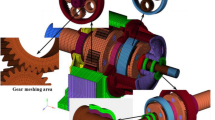Abstract
To improve the dynamic performance and reduce the weight of the planet carrier in wind turbine gearbox, a multi-objective optimization method, which is driven by the maximum deformation, the maximum stress and the minimum mass of the studied part, is proposed by combining the response surface method and genetic algorithms in this paper. Firstly, the design points’ distribution for the design variables of the planet carrier is established with the central composite design (CCD) method. Then, based on the computing results of finite element analysis (FEA), the response surface analysis is conducted to find out the proper sets of design variable values. And a multi-objective genetic algorithm (MOGA) is applied to determine the direction of optimization. As well, this method is applied to design and optimize the planet carrier in a 1.5MW wind turbine gearbox, the results of which are validated by an experimental modal test. Compared with the original design, the mass and the stress of the optimized planet carrier are respectively reduced by 9.3% and 40%. Consequently, the cost of planet carrier is greatly reduced and its stability is also improved.
Similar content being viewed by others
References
Rosenberg R S. Simulation of genetic populations with biochemical properties. Dissertation for the Doctoral Degree. Ann Harbor: University of Michigan, 1967
Schaffer J D. Multiple objective optimization with vector evaluated genetic algorithms. In: Proceedings of the 1st International Conference on Genetic Algorithms. Pittsburgh, 1985, 93–100
Rodriguez-Vazquez K, Fonseca C M, Fleming P J. Multiobjective genetic programming: A nonlinear system identification application. In: Proceedings of the Genetic Programming 1997 Conference. California, 1997, 207–212
Fonseca C M, Fleming P J. Nonlinear systems identification with multi-objective genetic algorithms. In: Proceedings of the 13th World Congress of IFAC. San Francisco, 1996, 187–192
Fonseca C M, Fleming P J. An overview of evolutionary algorithms in multiobjective optimization. Evolutionary Computation, 1995, 3(1): 1–16
McInerny S A, Hardman W, Keller J A, et al. Detection of a cracked planet carrier. In: Proceedings of the 10th International Congress on Sound and Vibration. Stockholm, 2003, 4981–4988
Blunt D M, Keller J A. Detection of a fatigue crack in a UH-60A planet gear carrier using vibration analysis. Mechanical Systems and Signal Processing, 2006, 20(8): 2095–2111
Keller J A, Grabill P. Vibration monitoring of UH-60A main transmission planetary carrier fault. In: Proceedings of the 59th American Helicopter Society Annual Forum. Phoenix, 2003, 1233–1243
Eritenel T, Parker R G. Modal properties of three-dimensional helical planetary gears. Journal of Sound and Vibration, 2009, 325(1–2): 397–420
Zhang Z H, Liu Z M, Zhang H P, et al. Structural analysis and optimization on the planet frame of large scaled gearbox of wind turbine. Journal of Machine Design, 2008, 25(9): 54–56 (in Chinese)
Xing Y, Moan T. Multi-body modeling and analysis of a planet carrier in a wind turbine gearbox. Wind Energy (Chichester, England), 2013, 16(7): 1067–1089
Alì G, Butera F, Rotundo N. Geometrical and physical optimization of a photovoltaic cell by means of a genetic algorithm. Journal of Computational Electronics, 2014, 13(1): 323–328
Affi Z, EL-Kribi B, Romdhane L. Advanced mechatronic design using a multi-objective genetic optimization of a motor-driven fourbar system. Mechatronics, 2007, 17: 489–500
Rossetti A, Macor A. Multi-objective optimization of hydromechanical power split transmissions. Mechanism and Machine Theory, 2013, 62: 112–128
Pang X, Rybarcyk L J. Multi-objective particle swarm and genetic algorithm for the optimization of the LANSCE linac operation. Nuclear Instruments & Methods in Physics Research. Section A, Accelerators, Spectrometers, Detectors and Associated Equipment, 2014, 741: 124–129
Sanaye S, Katebi A. 4E analysis and multi objective optimization of a micro gas turbine and solid oxide fuel cell hybrid combined heat and power system. Journal of Power Sources, 2014, 247: 294–306
Velea MN, Wennhage P, Zenkert D. Multi-objective optimization of vehicle bodies made of FRP sandwich structures. Composite Structures, 2014, 111: 75–84
Hao D, Wang D. Finite-element modeling of the failure of interference-fit planet carrier and shaft assembly. Engineering Failure Analysis, 2013, 33: 184–196
Yi P, Dong L, Chen Y. The multi-objective optimization of the planet carrier in wind turbine gearbox. Applied Mechanics and Materials, 2012, 184–185: 565–569
Park C I L. Multi-objective optimization of the tooth surface in helical gears using design of experiment and the response surface method. Journal of Mechanical Science and Technology, 2010, 24(3): 823–829
Yadav P K, Agarwal S, Yadav R K. Optimization of a truss structure using FEA and surface response method. International Journal of Applied Engineering Science, 2014, 9(1): 81–86
Chakraborty S, Sen A. Adaptive response surface based efficient finite element model updating. Finite Elements in Analysis and Design, 2014, 80: 33–40
Carrano E G, Cardoso R T N, Takahashi R H C, et al. Power distribution network expansion scheduling using dynamic programming genetic algorithm. IET Generation, Transmission & Distribution, 2008, 2(3): 444–455
Park E, Lee Y J. Estimation of standard deviation of Spearman rank correlation coefficients with dependent observations. Communications in Statistics Simulation and Computation, 2001, 30(1): 129–142
Rajmohan T, Palanikumar K. Application of the central composite design in optimization of machining parameters in drilling hybrid metal matrix composites. Measurement, 2013, 46(4): 1470–1481
Author information
Authors and Affiliations
Corresponding author
Rights and permissions
About this article
Cite this article
Yi, P., Dong, L. & Shi, T. Multi-objective genetic algorithms based structural optimization and experimental investigation of the planet carrier in wind turbine gearbox. Front. Mech. Eng. 9, 354–367 (2014). https://doi.org/10.1007/s11465-014-0319-5
Received:
Accepted:
Published:
Issue Date:
DOI: https://doi.org/10.1007/s11465-014-0319-5




